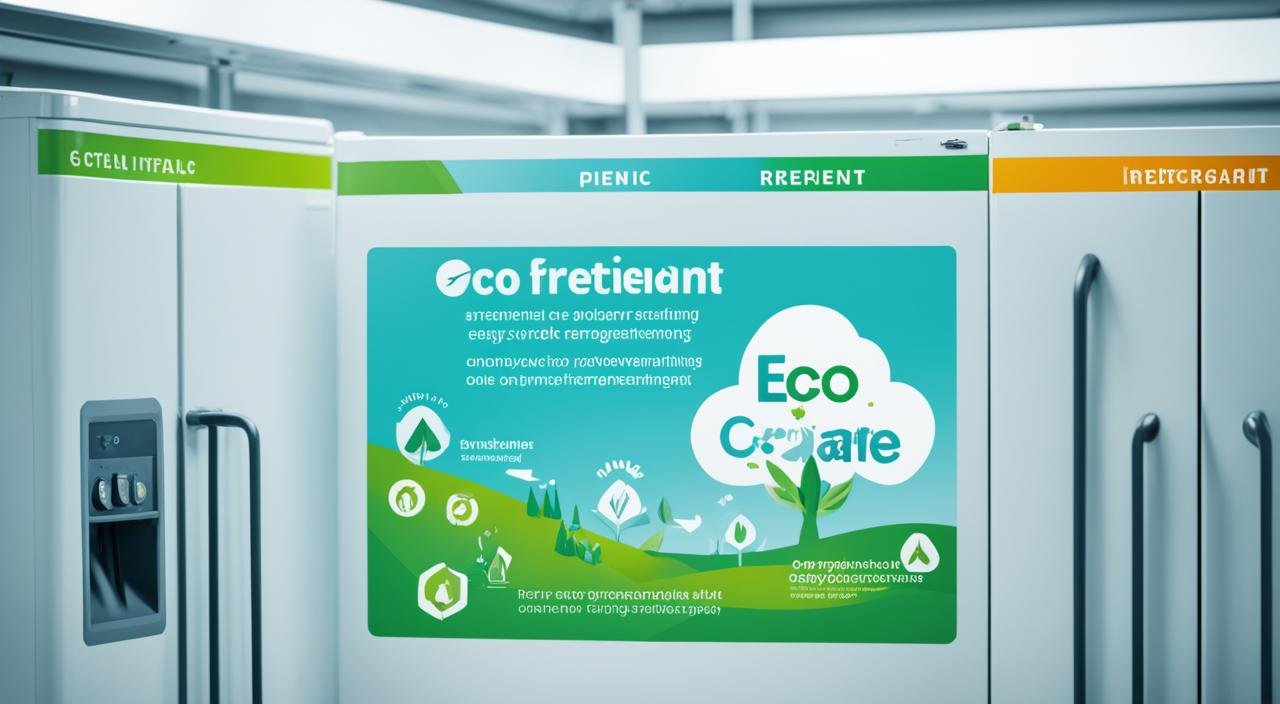Environmental awareness is rising, making more people look for eco-friendly options. Yet, just selling a green product isn’t a sure route to success. You need good marketing to show off your eco-friendliness and draw in people who care about the planet.
This article dives into eco-friendly marketing. It offers tips on how to sell eco products effectively. Knowing how customers think, using eco branding, and learning from green marketing success can help your brand do well. You’ll help the planet and grow your business at the same time.
Key Takeaways:
- Understanding consumer behavior is essential in developing targeted eco-friendly marketing strategies.
- Eco-conscious branding builds trust and connects with like-minded consumers.
- Successful green marketing examples demonstrate the effectiveness of sustainability initiatives.
- Implementing sustainable practices throughout your brand culture ensures authenticity.
- Appealing to eco-friendly consumers can increase customer loyalty and positive brand perception.
Understanding Consumer Behavior and Purchase Decisions
When people decide what to buy, they usually care more about basic features than sustainability. They look for products that will meet their specific needs and goals. Things like quality, price, and how well it works are key.
But, sustainability becomes important after finding a suitable product. Then, the product’s social and environmental benefits start to matter in the choice.
To market green products well, it’s key to tie sustainability to what the product does best. Showing that eco-friendly aspects support the main benefits helps a lot.
“Consumers prioritize basic product attributes when making purchase decisions. However, sustainability considerations come into play once consumers have identified a product that meets their primary requirements.”
If someone is buying laundry detergent, they might first look for effective stain removal and a nice smell. Afterwards, they could consider if the packaging is made from recycled materials or if it’s eco-certified.
Knowing what matters most to buyers helps market the eco-sides of products well. This way, the green parts add extra value to what matters most to people.
The Role of Product Attributes
What a product offers is really important to buyers. Quality, price, how it works, and how it looks all matter. But now, being good for society or the planet is being considered too.
Marketers can show how a green product makes the buying experience better. Like a skincare company could talk about using natural ingredients that are also sourced responsibly.
This approach helps connect the green parts of a product with what people want most. It makes marketing messages more powerful and more likely to lead to sales.
Segmentation and Customization
The market is made up of many different people with their own take on sustainability. Some might value supporting fair trade, while others may care more about reducing plastic waste.
Marketers can speak their language by tailoring messages to different groups. This helps brands meaningfully connect with their audience.
Getting how and why people choose eco-friendly products is key to success. By focusing on what the product does best and pointing out green benefits, marketers can make a real difference. It helps grow the market for products that are good for both people and the planet.
The Growth of Sustainable Products in the Market
Sustainable products are becoming more important in today’s market. They are growing fast and many people are paying attention. This is because there’s a bigger focus on taking care of the earth. The demand for these kinds of products is getting higher every day.
The growth of sustainable items has been very fast, even faster than usual products. More and more, buyers are picking eco-friendly options. They choose these items because they want to reduce their impact on the environment.
“The growing trend towards sustainability offers a tremendous opportunity for brands to tap into a broad and diverse consumer base.” – Market Analyst
Companies that make quality products and focus on being green win over more people. When these firms mix their ‘green’ promises with important parts of their brand, customers are more interested. This way, they connect with buyers on a deeper level.
A good way to talk about green products is to show how they help people and communities. Brands should talk about how their products make life better for individuals and the planet. This way, they make a real heart-to-heart connection with their customers.
The Benefits of Sustainable Products:
- Reduced carbon footprint
- Preservation of natural resources
- Support for ethical and fair trade practices
- Contribution to a healthier environment
This kind of approach attracts people who care about the planet and doing good for others. Sustainable products are appealing to a wide range of people. This gives companies a big chance to do well in the market by going green.
| Market Growth | Consumer Appeal |
|---|---|
| Sustainable products grow twice as fast as conventional ones. | Sustainable products appeal to consumers across all demographics. |
| Market forecast predicts continued growth in the sustainable product segment. | Consumers prioritize eco-friendly alternatives that align with their values. |
| Brands with sustainability initiatives outperform competitors. | Emphasizing personal and community benefits enhances consumer appeal. |
The Importance of Green Marketing and Eco-Conscious Branding
Green marketing is key for promoting products that are kind to the earth. This approach is vital for spreading the word about doing business in a way that is good for the planet. It includes making products, designing their packages, and their ads in ways that don’t harm the environment.
“Green marketing is not just about selling products; it’s about embracing sustainable ways of doing business and building a brand that aligns with consumers’ values.”
Unlike greenwashing, true green marketing is all about being real and open. Today’s buyers are smart and want to support brands that truly care. These brands work hard to protect our planet.
Creating eco-friendly products is a big part of green marketing success. This means thinking about a product’s entire life, from where its parts come from to what happens to it after use. It also includes choosing packaging that does the least harm.
Green branding is about more than the product; it’s about the values a brand stands for. Brands can show they care by doing things like cutting down on pollution and helping their local area. These efforts make a big difference.
Marketing Messages that Make a Difference
To connect with people who care about the planet, green marketing uses meaningful messages. It tells them how their choice can do good for the earth and society. This makes the brand more appealing to people who want to make a difference.
For instance, a clothing company can highlight its use of eco materials. They can show how buying their clothes helps the environment, encouraging customers to stay loyal. This approach makes everyone feel like they’re doing something good together.
Green marketing isn’t only about the planet; it’s about helping people and communities. Brands can talk about how they’re making lifestyles healthier, supporting fair trade, or helping local artists. The message is about the good that everyone’s purchase does.
The Power of Eco-Conscious Consumers
Consumers who care for the earth are a big influence today. They choose to buy from brands that share their eco-friendly values. These buyers are looking to support companies that care about the planet.
Brands that show they care through green marketing and eco-branding win over these eco-conscious consumers. This helps them grow their following. They become known as brands that care, which builds trust and loyalty.
Green marketing and sustainable branding aren’t just trends; they’re crucial for success in a world that values the environment. By showing their eco-commitment, brands can lead positive change while growing their business.
Successful Green Marketing Examples
Many brands have made green marketing work. They’ve shown that promoting green efforts to people who care works. This shows that being green can help with selling products.
Patagonia’s Worn Wear Initiative
Patagonia asks its customers to fix and reuse clothes instead of getting new ones. They talk about how long their items last. This way, they cut down on waste and show a better way to enjoy fashion.
Shades of Green’s Eco-Friendly Home Decor
Shades of Green makes safe and eco-friendly decorations for homes. They target people who love style but also the planet. This approach by the brand hits the mark with green-loving customers.
Pela’s Biodegradable Phone Cases and Accessories
Pela focuses on making things last. They offer phone cases and items that can break down without hurting the earth. This effort helps lessen the damage from old tech that piles up as waste.
Ten Thousand Villages’ Support for Artisans
Ten Thousand Villages helps artists in poor countries make a living. They sell the crafts made these artisans. It’s a win for everyone involved; the artists get to earn fair wages, and buyers get unique, green gifts.
Timberland’s Green Business Etiquette
Timberland is big on being good to the earth. They work to lower their pollution and use supplies in better ways. This move has earned them a big following from people who love a green focus.
These brands show that going green in marketing works. By talking about their eco-friendly sides, they win over shoppers. The demand for these kinds of products is growing, giving these companies a chance to do well and do good.
Green Marketing Strategies
Using effective green marketing strategies is key for brands wanting to highlight their commitment to the planet. These approaches help businesses connect with their audience. They also show how being eco-friendly can help both the Earth and profits.
Donation Incentives
Offering donation incentives is a strong green marketing move. It lets customers help causes they believe in when they buy. This can boost how people see a brand and help make a real difference for the planet.
Becoming a Certified B Corp
Getting certified as a B Corporation shows the world you care about more than just profit. It confirms a company’s dedication to being green and socially responsible. Such a certification builds trust and can spark new partnerships with other eco-friendly organizations.
Raising Awareness
Talking about your efforts for the planet is essential. Brands should share their green steps through blogs, social media, and news. This helps educate customers and encourages them to support sustainable choices.
Incorporating Sustainability into Brand Culture
Real green efforts start from within. Brands need to live and breathe sustainability. From making products to their delivery process, every step must be eco-friendly. This way, a brand can connect truly with people who care about the planet.
Collaboration with Other Eco-Friendly Brands and Initiatives
Working with other eco-conscious companies can make a big difference. Together, these brands can do more for the planet. They often do this through joint campaigns or product lines. Such teamwork spreads the green message far and wide.
Alignment with Mission and Target Customers
Choosing the right green steps is crucial. Brands need to pick initiatives that fit their goals and appeal to their customers. By focusing on what their fans care about, companies build real bonds and loyalty.
| Brand | Green Marketing Strategy |
|---|---|
| Patagonia | Worn Wear initiative promoting long-lasting clothing |
| Shades of Green | Creating non-toxic, eco-friendly home decor |
| Pela | Offering biodegradable phone cases and accessories |
| Ten Thousand Villages | Supporting artisans in developing countries |
| Timberland | Practicing green business etiquette and environmental stewardship |
Building Trust and Accountability
Brands aiming to sell eco-friendly products need to earn consumer trust. They do this by showing they are accountable in their efforts. This means being open about their goals and progress on sustainability.
Showing how many trees they’ve planted or using recyclable materials helps. It proves they are serious about their eco-friendly promises. These practices make consumers believe in what the brand says and does.
Sustainability messages are key in marketing. To connect with eco-conscious consumers, brands must highlight their green efforts. This can be through stories, compelling images, and by focusing on their product’s positive impact on the planet.
“Sustainability is not just about marketing; it’s about taking responsibility for our actions and making a difference. When brands incorporate sustainability messaging authentically and consistently, it resonates with consumers who are searching for eco-friendly options.” – Jane Thompson, Marketing Expert
Actively promoting green practices and proving their commitment wins trust. This builds loyalty among consumers who care about the environment. If consumers trust a brand, they not only buy from it again. They also recommend it to others who value the same eco-friendly ideals.
For eco-marketing to work, brands must build trust and be accountable. Being honest, using green messaging, and showing real progress are essential. This approach makes them leaders in a more sustainable future.
| Benefits of Building Trust and Accountability | Actions to Demonstrate Trust and Accountability |
|---|---|
| Enhanced brand reputation | Setting clear sustainability goals |
| Loyal customer base | Sharing progress and achievements |
| Increased consumer trust | Transparent communication |
| Positive word-of-mouth recommendations | Implementing eco-friendly practices |
The Power of Eco-friendly Consumers
Eco-friendly consumers play a big role in the market. They look for brands that care about the environment. These shoppers choose companies that support important causes.
This decision to buy is tied to a company’s social and environmental commitments. For businesses, serving these green consumers well can boost their profits.
Green buyers like brands that are big on sustainability. They value efforts to cut pollution, save resources, and act ethically. This view can lead to more trust and loyalty towards the brand.
“I always look for brands that prioritize sustainability. It gives me peace of mind knowing that my purchase is making a positive impact on the environment. I’m more likely to stick with those brands in the long run.”\n – Sarah, an eco-conscious consumer
Being loyal is a strong trait of eco-friendly customers. They stick with brands that are serious about the environment. They believe in these brands’ goals for a better future.
Brands that make eco-friendly efforts can keep these customers for a long time. They build lasting connections. This is because they share the same green values.
Yet, not all brands get this right. Those that ignore the environment might lose green customers. These shoppers want to see their values echoed in the brands they choose.
It’s vital for companies to tune in to what eco-friendly shoppers want. They need to adjust their practices. This helps them stay competitive in today’s eco-aware market.
Key Takeaways
- Eco-friendly consumers seek out brands that align with their values and prioritize sustainability.
- They have a more positive perception of companies that support social and environmental issues.
- Eco-friendly consumers are more likely to be loyal to brands that openly promote sustainability.
- Brands that do not prioritize sustainability may lose eco-friendly consumers.
Conclusion
In conclusion, to push eco-friendly products, we need to know what makes consumers tick. We should aim to change marketing to fit their needs. When we get that sustainability is just one part of a product, we can focus on what really matters to buyers.
Using green marketing helps brands become appealing to those who care about the planet. It creates a good image for the brand. Being open and honest about what we do, like our progress and goals, is key in a world that cares about the environment. Plus, as more people look for sustainable products, there’s a big chance for growth in this sector.
To sum up, we need to know what customers like, learn from green marketing success stories, and put sustainability first. By promoting green values and meeting the needs of eco-conscious customers, brands can do well and do good. They can not only help the planet but also improve their sales.
FAQ
What is green marketing?
Green marketing is making products that are good for the Earth. Companies market these items in sustainable ways. This includes using eco-friendly materials, being purpose-driven, and promoting their impact on the planet.
How do sustainable product features impact purchasing decisions?
Sustainable product features don’t always make people buy them. First, shoppers look for products that meet their needs. If sustainability is also offered, it can be a bonus.
Are sustainable products appealing to consumers?
Definitely, sustainable products are more popular than before. They are liked by all types of people. Making high-quality green products is key for catching the consumer’s eye.
What is the difference between green marketing and greenwashing?
Green marketing truly offers eco-friendly products. Opposite to this, greenwashing lies about being green.
Can you provide examples of successful green marketing?
Yes, successful green marketing includes Patagonia’s durable clothing that they encourage repairing. Shades of Green’s home decor is eco-friendly and safe. Pela makes compostable phone cases. Ten Thousand Villages helps artisans from poor countries. Timberland stands out for its eco-friendliness.
What strategies can be used for green marketing?
Key strategies are to make environmental issues part of a brand’s values. Cooperate with others in the green sector. Reward through donations. Get a B Corp certification. Inform customers about progress.
How can brands build trust and be accountable for their sustainability efforts?
Brands show they care about the planet through actions. They let people check on their promises. They share achievements like tree planting, or recycling success.
Do eco-friendly consumers have a positive perception of brands that support social and environmental issues?
Yes, people who care about the planet prefer brands that share similar values. They view companies supporting social and green causes in a better light.
How can brands attract eco-friendly consumers?
Marketing must understand what eco-friendly people want. Use green advertising methods. Most importantly, be truly committed to ecological sustainability.





